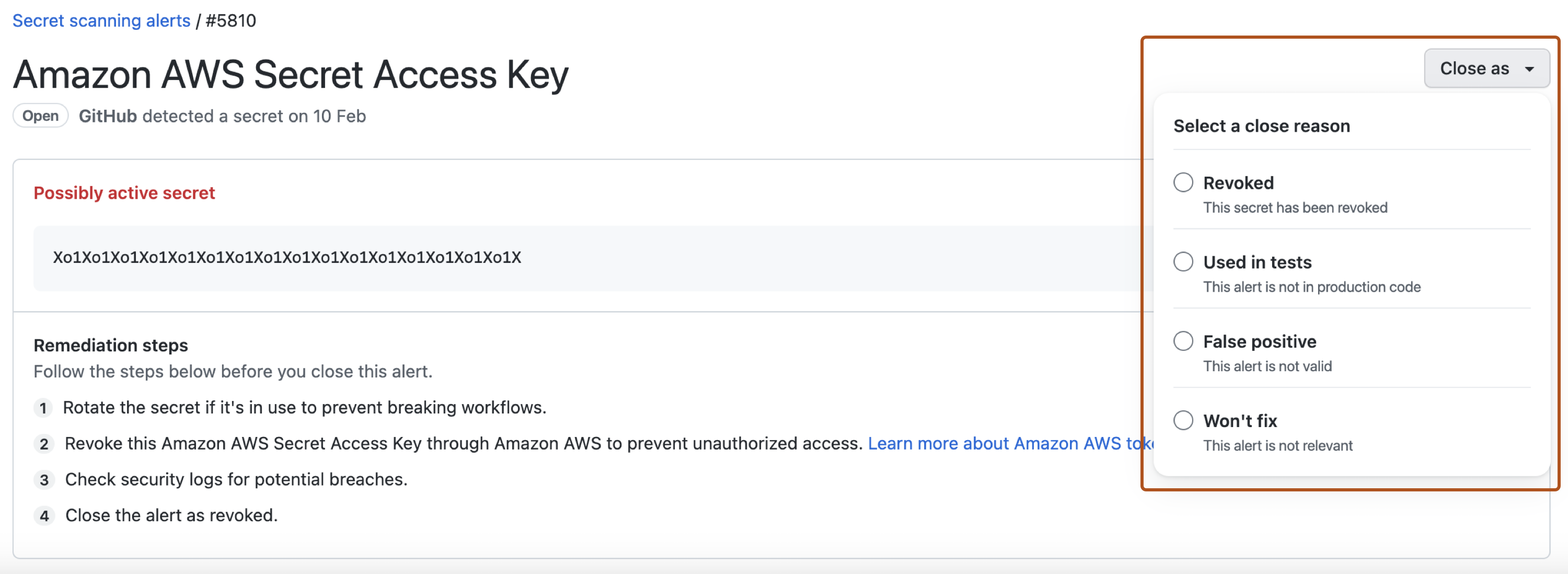About the secret scanning alerts page
When you enable secret scanning for a repository or push commits to a repository with secret scanning enabled, GitHub scans the contents for secrets that match patterns defined by service providers and any custom patterns defined in your enterprise, organization, or repository.
When secret scanning detects a secret, GitHub generates an alert. GitHub displays an alert in the Security tab of the repository.
Viewing alerts
- On your GitHub Enterprise Server instance, navigate to the main page of the repository.
- Under the repository name, click Security. If you cannot see the "Security" tab, select the dropdown menu, and then click Security.

- In the left sidebar, under "Vulnerability alerts", click Secret scanning.
- Under "Secret scanning", click the alert you want to view.
Filtering alerts
You can apply various filters to the alerts list to help you find the alerts you're interested in. You can use the dropdown menus above the alerts list, or input the qualifiers listed in the table into the search bar.
| Qualifier | Description |
|---|---|
is:open | Displays open alerts. |
is:closed | Displays closed alerts. |
secret-type:SECRET-NAME | Displays alerts for a specific secret type, for example, secret-type:github_personal_access_token. For a list of supported secret types, see "Secret scanning patterns." |
provider:PROVIDER-NAME | Displays alerts for a specific provider, for example, provider:github. For a list of supported partners, see "Secret scanning patterns." |
Fixing alerts
Once a secret has been committed to a repository, you should consider the secret compromised. GitHub recommends the following actions for compromised secrets:
- For a compromised GitHub personal access token, delete the compromised token, create a new token, and update any services that use the old token. For more information, see "Managing your personal access tokens."
- Identify any actions taken by the compromised token on your enterprise's resources. For more information, see "Identifying audit log events performed by an access token."
- For all other secrets, first verify that the secret committed to GitHub Enterprise Server is valid. If so, create a new secret, update any services that use the old secret, and then delete the old secret.
Closing alerts
-
On your GitHub Enterprise Server instance, navigate to the main page of the repository.
-
Under the repository name, click Security. If you cannot see the "Security" tab, select the dropdown menu, and then click Security.

-
In the left sidebar, under "Vulnerability alerts", click Secret scanning.
-
Under "Secret scanning", click the alert you want to view.
-
To dismiss an alert, select the "Close as" dropdown menu and click a reason for resolving an alert.

-
Optionally, in the "Comment" field, add a dismissal comment. The dismissal comment will be added to the alert timeline and can be used as justification during auditing and reporting. You can view the history of all dismissed alerts and dismissal comments in the alert timeline. You can also retrieve or set a comment by using the Secret scanning API. The comment is contained in the
resolution_commentfield. For more information, see "REST API endpoints for secret scanning" in the REST API documentation. -
Click Close alert.
Configuring notifications for secret scanning alerts
Notifications are different for incremental scans and historical scans.
Incremental scans
When a new secret is detected, GitHub Enterprise Server notifies all users with access to security alerts for the repository according to their notification preferences. These users include:
- Repository administrators
- Security managers
- Users with custom roles with read/write access
- Organization owners and enterprise owners, if they are administrators of repositories where secrets were leaked
Note: Commit authors who've accidentally committed secrets will be notified, regardless of their notification preferences.
You will receive an email notification if:
- You are watching the repository.
- You have enabled notifications for "All Activity", or for custom "Security alerts" on the repository
For more information about setting up notification preferences, see "Managing security and analysis settings for your repository" and "Configuring your watch settings for an individual repository."
Historical scans
For historical scans, GitHub Enterprise Server notifies the following users:
- Organization owners, enterprise owners, and security managers—whenever a historical scan is complete, even if no secrets are found.
- Repository administrators, security managers, and users with custom roles with read/write access—whenever a historical scan detects a secret, and according to their notification preferences.
We do not notify commit authors.
For more information about setting up notification preferences, see "Managing security and analysis settings for your repository" and "Configuring your watch settings for an individual repository."
Auditing responses to secret scanning alerts
You can audit the actions taken in response to secret scanning alerts using GitHub tools. For more information, see "Auditing security alerts."